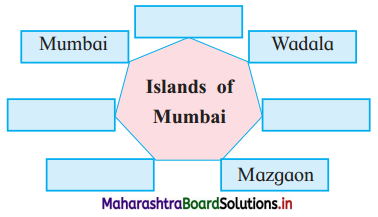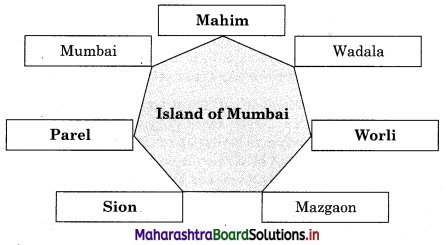Balbharti Maharashtra State Board Class 12 History Solutions Chapter 3 India and European Colonialism Textbook Exercise Questions and Answers.
Maharashtra State Board Class 12 History Solutions Chapter 3 India and European Colonialism
1A. Choose the correct alternative and rewrite the statement.
Question 1.
Vasco da Gama was a seafarer from ___________
(a) Poland
(b) England
(c) France
(d) Portugal
Answer:
(d) Portugal
![]()
Question 2.
The license was given by England to the East India Company to trade with eastern countries by ___________
(a) Sir George Oxenden
(b) Princess Braganza
(c) Queen Elizabeth
(d) Homer
Answer:
(c) Queen Elizabeth
1B. Find the incorrect pair from group ‘B’ and write the corrected one.
Question 1.
| Group ‘A’ | Group ‘B’ |
| (a) Arcebispo | Chief Executive Officer |
| (b) Chancellor | Judge |
| (c) Vedor da Fazenda | In charge of Company’s Possessions |
| (d) Capitaon | Captain |
Answer:
(a) Arcebispo – Archbishop
2. Complete the concept map.
Question 1.

Answer:

3. Explain the following statements with reasons.
Question 1.
The Indian rulers had to obtain Cartaz.
Answer:
Cartaz: The Cartaz was a license issued by the Portuguese to the Indian rulers for sailing on the Indian Ocean when they established firm control of the Indian Ocean. It usually carried details like the name of the vessel (ship), the name of the captain of the ship, port of departure and arrival, the list of weaponry on the ship loaded for the purpose of self-defense, etc.
![]()
Question 2.
Indian rulers found it difficult to fight the Portuguese.
Answer:
The Portuguese established a strong navy. They used to launch sudden attacks on their enemy’s territory from the sea and wreck it completely. The Indian rulers could not match the Portuguese in their war tactics. Later when they established their firm control on the Indian Ocean it became necessary for the Indians to get a license from them for sailing on the Indian Ocean.
4. Answer the following questions in detail.
Question 1.
Which are the places where the Portuguese established their colonies?
Answer:
By 1608, the Portuguese had established their colonies on the western coast of India at Diu, Daman, Chaul, Goa (including Sashti and Bardish), Honnavar, Gangoli, Basrur, Mangalore, Kannur, Kodungallur, Kochi, and Kollam. Similarly, on the eastern coast, they had trader colonies at Nagapattinam, Mylapore or Sao Tome/San Thom, and Hugli in Bengal. This stretch of the Portuguese empire had its capital at Goa.
Question 2.
What were the rights given to United East India Company by the Dutch government?
Answer:
The Dutch government issued a license to the company to conduct trading with the eastern countries. The same license permitted them to appoint staff, establish factories, build forts, engage in battles against the eastern countries, and also sign treaties with them. Accordingly, the company appointed a Governor-General to take care of Indian affairs.
Class 12 History Chapter 3 India and European Colonialism Intext Questions and Answers
Try to do this (Textbook Page No. 19)
Collect information of the church in Kerala, named after Vasco da Gama, with the help of the internet.
Answer:
St. Francis Church:
- Built-in 1503 as one of the oldest European churches in India.
- Originally known as St. Bartholomew.
- Constructed of wood and stone.
- First Portuguese church in India.
- Founded by Pedro Alvarez De Cabral.
- Built-in Persian architecture style.
- The Portuguese built a fort and within the fort, they built a church.
- History has it that Vasco da Gama died during his third visit to India and was buried here in 1524.
- After 14 years his body was moved to Lisbon.
Try to do this (Textbook Page No. 21)
Make a list of the ship-building facilities in pre-independence and post-independence India and collect information about the development of the shipbuilding industry.
Answer:
Students can use the following points as references.
- India’s maritime history began during the 3rd millennium B.C.E.
- When Indus valley had trade contact with Mesopotamia.
- Strabo mentions Rome and Greece had maritime trade relations with India.
- The Portuguese were the first Europeans to reach India by sea and traded in spices etc. followed by the Dutch.
- The shipbuilding activities of Chhatrapati Shivaji Maharaj are particularly noteworthy. Chhatrapati Shivaji Maharaj built a strong naval force.
- In the modern period, the British East India Company shipped substantial quantities of spices.
- Ship Building was a well-established craft.
- Some of the well-known shipyards in India today are Sembmarine Kakinada Ltd (SKL) India, Goa Shipyard Limited (GSL) India, Western India Shipyard Ltd.
![]()
Try to do this (Textbook Page No. 21)
The currency of various countries is known by specific names. Prepare a list of countries and their currencies.
Answer:
| Country | Currency |
| 1. Afghanistan | Afghan Afghani (AFN) |
| 2. Argentina | Argentine peso (ARS) |
| 3. Australia | Australian dollar (AUS) |
| 4. Bahrain | Bahraini dinar (BHD) |
| 5. China | Chinese yuan (CNY) |
| 6. Denmark | Danish krone (DKK) |
| 7. Egypt | Egyptian pound (EGP) |
| 8. Germany | Euro (EUR) |
| 9. India | Indian rupee (INR) |
| 10. Japan | Japanese yen (JPY) |
| 11. United States of America | US dollar (USD) |
| 12. United Kingdom | Pound sterling (GBP) |
Project (Textbook Page No. 23)
Compile the names of Governors of British East India Company from 1600 to 1857. C.E.
Answer:
The Regulating Act of 1773 created the office with the title of Governor-General of Presidency of Fort William or Governor-General of Bengal. He was appointed by the Court of Directors of the East India Company.
| Governor-General | Years Active |
| 1. Warren Hastings | 1772 – 1785 |
| 2. Sir John Macpherson | 1785 – 1786 |
| 3. Lord Cornwallis | 1786 – 1793 |
| 4. Sir John Shore | 1793 – 1798 |
| 5. Lord Wellesley | 1798 – 1805 |
| 6. Sir George Barlow | 1805 – 1807 |
| 7. Lord Minto I | 1807 – 1815 |
| 8. Lord Hastings | 1813 – 1823 |
| 9. Lord Amherst | 1823 – 1828 |
| 10. Lord William Bentinck | 1828 – 1835 |
| 11. Sir Charles Metcalfe | 1835 – 1836 |
| 12. Lord Auckland | 1836 – 1842 |
| 13. Lord Dalhousie | 1848 – 1856 |
| 14. Lord Canning | 1856 – 1862 |
| 15. Lord Lawrence | 1864 – 1869 |
| 16. Lord Mayo | 1869 – 1872 |
| 17. Lord Lytton | 1876 – 1880 |
| 18 .Lord Ripon | 1880 – 1884 |
| 19. Lord Dufferin | 1884 – 1888 |
| 20. Lord Lansdowne | 1888 – 1894 |
| 21. Lord Curzon | 1894 – 1905 |
| 22. Lord Minto | 1905 – 1910 |
| 23. Lord Hardinge | 1910 – 1916 |
| 24. Lord Chelmsford | 1916 – 1921 |
| 25. Lord Reading | 1921 – 1926 |
| 26. Lord Irwin | 1926 – 1931 |
| 27. Lord Willingdon | 1931 – 1936 |
| 28. Lord Linlithgow | 1936 – 1944 |
| 29. Lord Wavell | 1944 – 1947 |
| 30. Lord Mountbatten | March 1947 – August 1947 |